#extremophiles
Note
https://explorersweb.com/lichen-survives-space/ <- this seems like something you would find cool (in case you haven't seen it yet). lichen survives space!!
Good job, little guys! Very proud of you! But this isn't the first times lichens have survived in space or survived space-like conditions.
Lichens Survive in Space: Results from the 2005 LICHENS Experiment
Characterization of Viability of the Lichen Buellia frigida
After 1.5 Years in Space on the International Space Station
Lichen Vitality After a Space Flight on Board the EXPOSE-R2 Facility Outside the International Space Station: Results of the Biology and Mars Experiment
Viability of the lichen Xanthoria elegans and its symbionts after 18 months of space exposure and simulated Mars conditions on the ISS
Survival of lichens and bacteria exposed to outer space conditions -Results of the Lithopanspermia experiments
Whole Lichen Thalli Survive Exposure to Space Conditions: Results of Lithopanspermia Experiment with Aspicilia fruticulosa
Some lichens are so good at surviving extreme conditions that some of the most common experiments done on them are basically *put lichen in situation* *observe reaction*. I am analyzing some data right now where we subjected lichens to salt stress. Maybe I admire lichens so much because my response to any amount of change to my environment is cry?
#lichen#lichens#extremophiles#lichens in space#space#astrobiology#lichenology#lichenologist#science#science side of tumblr#I love studying lichens#I admire them so much#just little guys
45 notes
·
View notes
Text
youtube
more cool content from Deep Look!
#bugs#bugblr#insects#insect#bug#entomology#found elsewhere and uploaded by me#diptera#alkali flies#alkalinfly#mono lake#extremophiles#Youtube
26 notes
·
View notes
Text
(Please no vanilla extract or micro plastics this time—pollution is no laughing matter)
#poll#marine life#marine biology#deep sea#hydrothermal vent#extremophiles#fish#cephalopods#worms#molluscs#crabs#bacteria
50 notes
·
View notes
Text
12 notes
·
View notes
Text
It's right and fair and just to mourn the species gone or going extinct in the span of humanity's lifetime. It does suck. But the point of no return we are past is the prevalence of biological activity on Earth. This planet already lost its chance to become another Mars or Venus.
Life was born before there was breathable air, before land was habitable, and continued to produce survivors through Snowball Earth, the Great Dying and Chixculub. The Age of Mammals came because the Age of Birds went.
There are worms a mile underground and vertebrates at the bottom of the Mariana Trench. There are whole ecosystems living off of hydrogen sulfide around hydrothermal vents hotter than lead's melting point, and bacteria in boiling volcanic springs. There are fungi that have already learned how to feed off of polyurethane in Ecuador and gamma rays in Chernobyl.
Adaptive radiation. Survivors will inherit the world. They always have.
#adaptive radiation#(the phenomenon in which survivors of extinction events rapidly produce volunteers to fill in all the new vacancies in ecological niches)#wish luck to the weeds and the pests and the extremophiles. whether in years or eons the world will be theirs next.#extremophiles#environmentalism#earth#tldr#musings
15 notes
·
View notes
Note
After reading some of your posts for the last few days, the shoe finally dropped that the "Nonavian" in "Nonavian dinosaurs" is non avian and not an adjective relating to some scientist or period Nonave or Nonavius or something like that🤦♀️
But since I'm already here, do we know of any extremophile prehistoric dinosaurs (or suspect that one might be)?
Because I know that flamingos can live under very extreme situations, but I wonder if there was an older dino that could deal with environments like that.
Not that I’m aware of, it might be hard to determine from the fossil record
17 notes
·
View notes
Text
flamingos are extremophiles
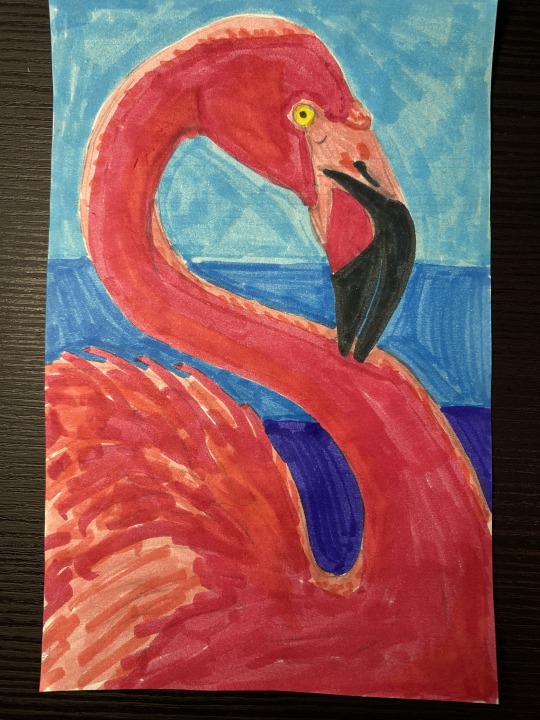
You can’t look at these birds that can live in boiling salty alkaline water and not say they qualify as BEASTS.
4 notes
·
View notes
Text
Cyanidium caldarium has managed to adapt to the highly acidic conditions by being able to pump acid out of its cells and using acid-resistant polysaccharide molecules to protect the cells from the acidic environment.

"Chemistry" 2e - Blackman, A., Bottle, S., Schmid, S., Mocerino, M., Wille, U.
#book quote#chemistry#nonfiction#textbook#cyanidium caldarium#algae#aotearoa#new zealand#whakaari#white island#crater lake#adaptation#extremophiles#acid#polysaccharide
5 notes
·
View notes
Text
Did you know?🌿

Flamingos are extremophiles, meaning they are a species capable of surviving in harsh environments. Flamingos can withstand direct UV exposure, as well as hot and cold climates. They’ve even been known to nest in corrosive lakebeds!
3 notes
·
View notes
Text
Tough as a Tardigrade: Space-dwelling lifeforms in Star Trek
By Ames

Star Trek spends a lot of episodes going where no one has gone before (except where someone definitely already has), and that includes just floating around in the vastness of space itself. But time and again, we find creatures who can survive even out here in the void, who don’t need a ship, a suit, gravity, oxygen, air pressure, or really any resources at all. And also who can survive cosmic radiation and all the other death traps even the Enterprise has trouble dealing with.
These are some resilient critters, so this week A Star to Steer Her By is shining a spotlight on the extremophiles of the cosmos! From lowly amoebas to much bigger amoebas, space-dwelling lifeforms come in all shapes, sizes, and tangibilities. Prepare to spacewalk with us as you read on below or listen to our chatter on this week’s podcast episode (discussion starts at 1:29:44) as we befriend these noble creatures and run away from the scary ones.
[images © CBS/Paramount]

Spore flowers – “This Side of Paradise”
You almost miss this reference in an early episode of The Original Series, but it’s stated that the spores of the motivation-draining flowers traveled through space until they settled on paradise planet. Make them a mint julep for their tenacity!

Dikironium cloud creature – “Obsession”
Kirk’s white whale… er, cloud in “Obsession” definitely travels about through space on its own, even getting into the Enterprise itself through some duct or other. You may want to keep your hemoglobin to yourself if you come across this sucker.

Space amoeba – “The Immunity Syndrome”
We almost lose Spock to this massive version of a lowly single-celled organism, which drains the energy from the ship. Unlike the Moby Dick cloud above, this one seems to have a taste for Vulcans! Must be that tasty green blood.
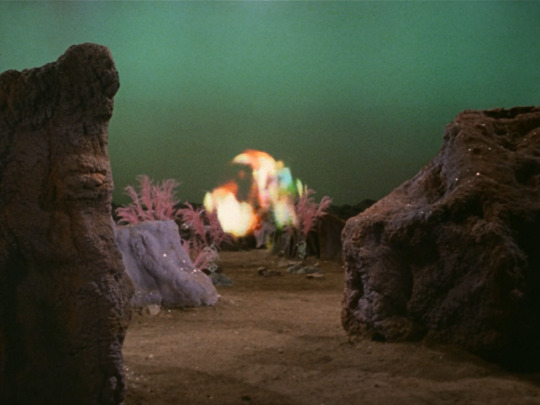
Beta XII-A entity – “Day of the Dove”
The angry little pinwheel we meet on Beta XII-A also likes to flap around in space to follow the crew back to the Enterprise and piss everyone off. No really, all it wants to do is piss everyone off and feed off their hate. These things should get into politics.
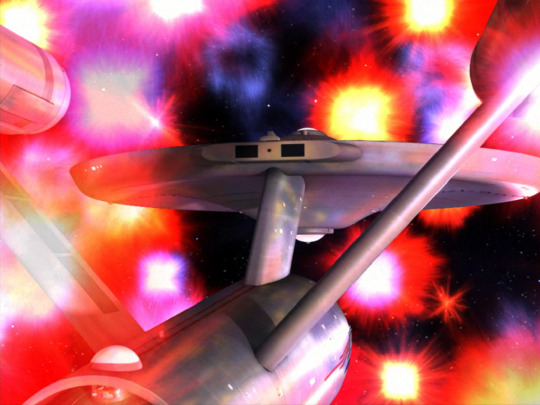
Zetarians – “The Lights of Zetar”
Another flashy flashy light that follows people around through space, these colorful beings are just looking for a place to live… and that happens to be inside crewmen of the Enterprise. If they’d succeeded, they probably would have gone on our character possession list!

Matter-energy cloud – “One of Our Planets Is Missing”
I remember really liking this episode from The Animated Series, which is a rarity, because of the big sentient cloud that Spock gets to mindmeld reminding me of A Star to Steer Her By’s first fanfic day! And happily, both live on today!

Q – “Encounter at Farpoint” et al
When we first meet Q in the TNG premiere, he’s just a chain link fence in space. Shortly afterwards, we see him chase the ship as some kind of translucent ball. Basically, the Q are so powerful, they can exist wherever, whenever, and as whatever they want.
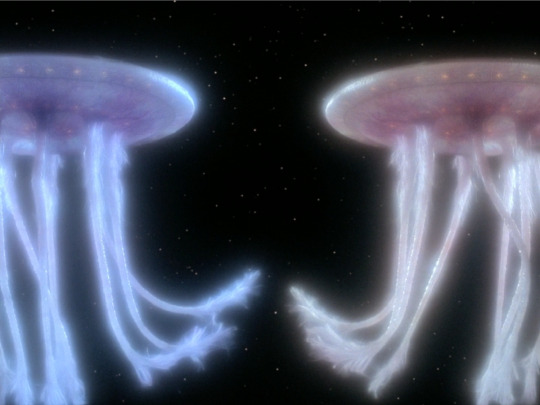
Space Jellyfish – “Encounter at Farpoint”
One of my personal favorites because of just how alien these things are. Kicking off The Next Generation with a pair of space jellyfish at the center of a mysterious test got things off to a great start. The rest of season one on the other hand…

Beta Renner cloud – “Lonely Among Us”
This highly forgettable episode did at least feature some interesting creatures who bring Picard’s essence with them to live in space and do whatever it is they like to do. It doesn’t last long, but it did happen.
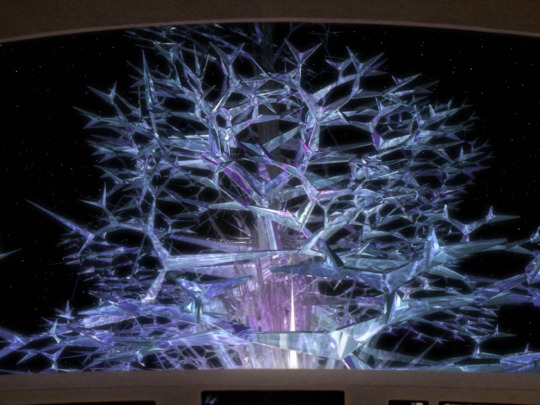
Crystalline Entity – “Datalore” and “Silicon Avatar”
There are few creatures as spangly and stunning as the crystalline entity. Like all the pretty ones, it just happens to also like mass murder quite a bit, and also hanging out with psychopaths like Lore. Who can blame it though?
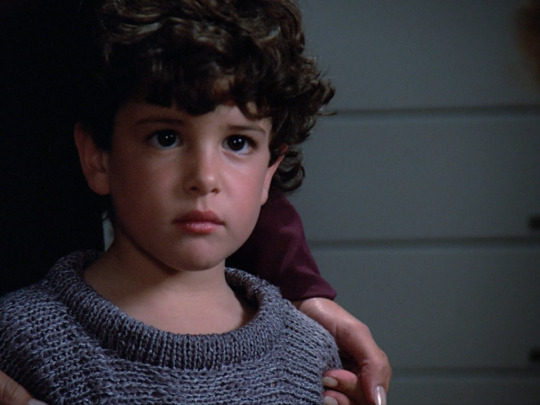
The Child – “The Child”
When Troi gets knocked up in the season two premiere of TNG, it’s by none other than some kind of space-dwelling light being. Little Ian Andrew just wants to learn more about the human race, from the inside out.

Nagilum – “Where Silence Has Lease”
In literally the next episode, yet another space-dwelling weirdo also wants to learn more about the human race, though this one is less innocent in how he goes about it. Let’s count how many different ways people can die. You know, for science!

Subatomic bacteria – “A Matter of Honor”
Our Benzite friend Mendon spots some subatomic bacteria on the hull of the Klingon vessel Pagh and doesn’t report it until another batch is found on the Enterprise. Who knows how many other infestations of this space-dwelling scum he hasn’t reported!?

Calamarain – “Deja Q”
Many of the lifeforms in space whom we meet are just incorporeal, and that includes the Calamarain who hold a grudge against Q for some infractions over the years. They nearly get their revenge in the brief time Q is human too.

Gomtuu – “Tin Man”
Megafauna in space is less common, but we do see some good ones. Like Gomtuu, a perfectly sentient creature living out the rest of his days with his Betazoid inhabitant. Sadly, it does seem that he may be the last of his kind.

Two-dimensional beings – “The Loss”
When Troi loses her empathic powers, she’s unable to sense the two-dimensional beings that the ship comes across. They’re a fairly interesting alien race, since you can’t even perceive the dimension they live in whether you’ve got a functioning empath or not!

Junior – “Galaxy’s Child”
Picard wasn’t the only one devastated to see the Enterprise accidentally kill a space-dwelling mega-ravioli since it was a very cool critter to meet. Luckily, her child, dubbed “Junior,” survives, just a little bit al dente.

Quantum singularity lifeforms – “Timescape”
The aliens we meet on the Romulan ship are so hardcore that they raise their young inside a singularity. And like a typical outlandish Romulan scheme, Romulan ships are so convoluted they’re powered by an artificial singularity. Talk about a Black Hole Son! (Rimshot.)

Wormhole aliens and pah-wraiths – Deep Space Nine
We move on to the space hoppers in Deep Space Nine, starting with the series-wide plotline of the prophets who live in the wormhole and the pah-wraiths who live in the firecaves. But when they’re summoned, they basically go where they want.

Vash’s artifact – “Q-Less”
Quark and Vash try to sell what turns out to be the egg of a creature from the Delta Quadrant. When it hatches, it’s incredibly beautiful, but I gotta admit I don’t know what I’d do either if a million bars of gold-pressed latinum were on the line.

Rumpelstiltskin, et al – “If Wishes Were Horses”
Boy did we (as usual, mostly I) not like this episode, and most of that has to do with how contradictory these aliens are. Like some of the previous instances of aliens learning how humans work, their agenda is convoluted at best and confounding at worst.

Changelings – “Chimera” et al
Since Changelings can form themselves as whatever they want, that includes beings and objects you can find in space. We specifically see Laas swimming through the void as some kind of space whale, but certainly other Changelings must do it too.

Nucleogenic cloud being – “The Cloud”
Let’s now visit some of our outside pets of the Delta Quadrant. Early in Voyager, we meet the titular Cloud being that the ship accidentally ends up inside, and learn that, if there’s a cute animal in danger, Janeway must save it!

Komar – “Cathexis”
Another incorporeal alien we also brought up in our character possessions discussion, the Komar also can live outside the ship in space somewhere. These parasites usually reside in a nebula until a tasty-looking snack like Tuvok happens along.

Space sperms – “Elogium”
While Kes is having a sexual awakening in this rather uncomfortable episode, the Voyager herself is trying her best not to have one with these space sperms that are in the middle of a mating frenzy. What’s a nice ship like you doing in a quadrant like this?

Matrix species – “Coda”
We don’t get a good look at this actual alien species other than in the guise of Janeway’s dad, but it is insinuated that their matrix dimension they are trying to lure her into is in some kind of ethereal space. Captain, don’t walk into the light!
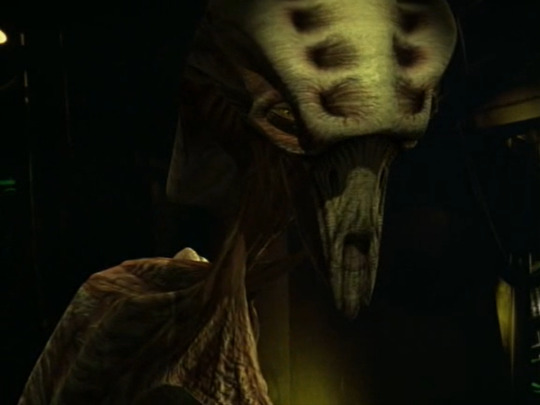
Species 8472 – “Scorpion” and “Prey”
Species 8472 is truly alien in many ways, including all the places they’re able to live. Normally natives of fluidic space, they can also survive in the vacuum of space, as we see when they get onto the Voyager in “Prey.”
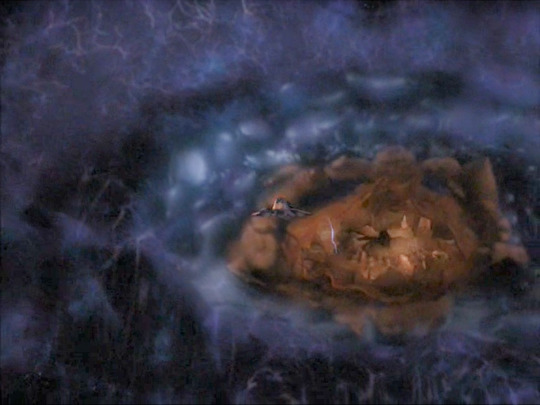
Bioplasmic organism – “Bliss”
Like Captain Kirk’s cloud in “Obsession,” the big space pitcher plant proves to be a white whale to our new friend Qatai. This thing is huge and actually impressive to see since its CGI holds up pretty well! That is, when you can see it for what it is of course.

Bevvox – “Think Tank”
A similar (though smaller?) example of a bioplasmic organism is Bevvox, who we can only assume is some kind of space brainbox. He floated around in space for millennia before having the bright idea to form the Think Tank of the episode of the same name.

Species GS84 – “Context Is for Kings”
We now jump straight into Discovery, and season 1 had a whole bunch of space-dwelling lifeforms to appreciate. In an almost throwaway scene, these little light leeches start draining the energy of the shuttle and get the pilot killed before the Discovery picks everyone else up.

Ripper – “The Butcher’s Knife Cares Not for the Lamb’s Cry” et al
The standout star of season 1 of Discovery, of course, is Ripper and I’ll not be hearing any arguments otherwise. This massive tardigrade, first thought to be a menace, turns out to be a great pilot before being freed from the slavery of the ship and straight into space to thrive.

Gormagander – “Magic to Make the Sanest Man Go Mad”
Unless you’re Jonah, you don’t typically travel via whale. Harcourt Mudd, however, travels in style inside an endangered Gormagander. The space cetacean is a beautiful creature, though it does make me wonder why whales have come up so much in this blogpost?
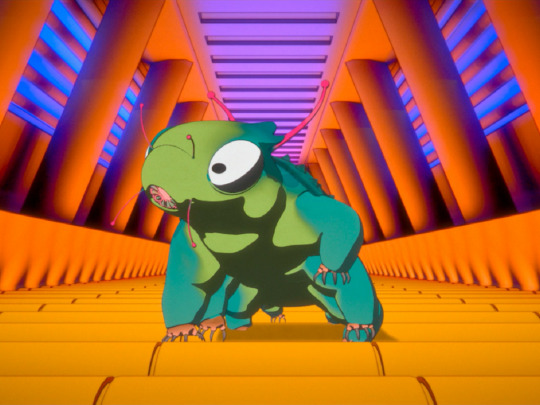
Ephraim – “Ephraim and Dot”
We see another tardigrade in one of the Short Treks, though this one is neither massive like Ripper nor microscopic like tardigrades we may find on Earth (or on the moon!). What Ephraim is is adorable and colorful, much like her entire animated episode!
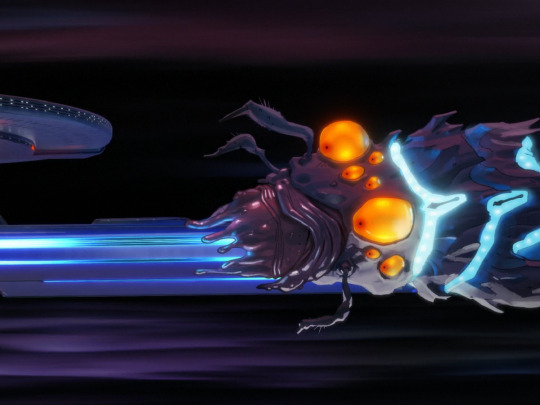
Larval space creature – Lower Decks opening credits
Another animated lifeform we see out in space comes in Lower Decks. We’ve agreed that the opening title sequence of Star Trek’s comedy cartoon show has some of the best jokes of the whole series, and the big space bug sucking on the nacelle is one of them! Ha!

Verugament – “Grounded”
In the most recent season of Lower Decks, there’s a swarm of another space-dwelling organism, the verugament. And because it’s a silly jokey show, as soon as they come in contact with the Cerritos, it triggers a mating response and things get... squishy.

Murf – Prodigy
Last but certainly not least, we have everyone’s favorite mellanoid slime worm from Prodigy! Murf can survive pretty much anything! Little seems to be known about his species except that they will swoop in and save the day whenever called upon.
—
Come back inside before you get eaten by a space monster! As always, keep following this space for more great Trek topics, jetpack along with our watch through of Voyager on SoundCloud or your favorite podcasting application, tap the glass on our Facebook and Twitter pages, and save the space whales!
#star trek#star trek podcast#podcast#space-dwelling lifeforms#aliens#extremophiles#tardigrades#space whales#sentient cloud#the original series#the animated series#the next generation#deep space nine#voyager#discovery#short treks#lower decks#prodigy#murf
12 notes
·
View notes
Text
youtube
#I want to go to Yellowstone SO badly#the visuals here are… insane#grand prismatic spring#yellowstone national park#extremophiles#Youtube
1 note
·
View note
Text

Last Contact
A generation ship, the first of its kind, bioengineered by some of the most prominent technological collectives in the system, was scheduled for its final departure after picking up a group of researchers from a station at the edge of the Keiper Belt. Soon after leaving the solar system, however, it became clear that they were not alone.
Before them was the first in a series of massive, sapient extremophiles utilizing the biological equivalent of solar sails and traveling in a group towards Earth. While first contact had been speculated about since before the evolutionary descendants of Corvids first arrived in space, no one had expected it to be quite like this.
Having finally made contact with their destination system, a series of high-frequency signals are beamed toward the ship. With attempts to make contact already in progress at the time the broadcast began, a variety of onboard systems were prepared to receive such a message from any number of sources, and that included the ship's communication system and network of mycelium-based computers.
Now, a small crowd begins to gather around one of the screens, witnessing a strange series of sounds and images, mesmerizingly flickering despite their almost nauseating pattern. This is it. First contact.
Soon the images become more discernable, displaying something that many watching quickly recognize.
"Are those...Primates?" One says in their language's equivalent.
"Looks like it."
Here, the first true images of the Human world, nearly a million years past reduced to nothing but fossils, sediment, and ice cores, are witnessed. As the signal is adjusted, the images are as well. What seems like a pair bringing food to a younger member of the species, examples of their methods of tool use, their early forms of space travel...Centuries of speculation put to rest as nothing but a sideshow to the most important discovery of the crew's lifetimes.
While much of the crew focuses on establishing more coherent communication, the onboard historical collective gets to work trying to glean as much information from the "video" as they can. They watch on, obsessively transmitting them back home as they do so.
In place of language, the Humans actions take on more meaning. It can be inferred that they made clear attempts at educating, caring for, and raising their young. They compensated heavily for their difficulty of movement and managed to overcome much of it. They made fascinating and beautiful art, and possessed intricate cultures.
Rectangles and circles, decorated with complex symbols of various colors, seemed to be of great importance to many, perhaps as a religious item, part of a gifting system, or some sort of odd technology. Whatever they were used for, they were important enough to them to kill over, and played a role in the distribution of resources.
Even less positive things can also be inferred. Throughout much of their history, they possessed governments and solidified systems of near-absolute hierarchy within their societies.
As it plays on, much of what can be seen becomes increasingly bleak. While warping nature in potentially horrifying ways was hardly a new concept to a species of prolific genetic and biological engineers, the annihilation of it was something that many hoped was simply a coincidence in the fossil record.
War too, while not unknown, was something Humans seemed to engage in unendingly. They perfected it with time. Perhaps much of it was fiction, after all, a planet-destroying moon would have undoubtedly been impossible given Earth’s limited resources. Still, what it indicated was something that to them must have seemed like an eternal bloodbath.
The final pieces came from videos that seemed be from soon after the peak of Human devleoplment. Statistically higher numbers of distinct depictions of environmental destruciton, the breakdown of their shelters and food supply, of transportation and available water. With it, their wars grew too.
Speculation of the extinction of the primates having been the result of climatic collapse was widespread. The amount of Co2 in the atmosphere appeared to have catastrophically risen at almost the exact same time that Humans ceased to exist in the fossil record. These videos confirmed that theory, and it was only a matter of time before the “how” could be too.
As the last set of videos was selected and approached its end, more surprises briefly pierced the somber mood of the viewers. Impossibly large explosions overlayed with flashing colors and vocalizing Humans. Now, this odd, symbol-filled screen, then darkness.
The last contact of a dead species.
#crow#crows#corvids#evolution#spec evo?#collapse#climate collapse#climate change#humanity#extremophiles#space#spaceship#bioengineering#anarchist#worldbuilding#story#nuclear war#art#digital art#aliens#scifi#first contact#(It's flickering because birds tend to perceive motion at a higher fps#I learned that in a Tumblr post.#This Grand Nest
7 notes
·
View notes
Text
Extremophiles? In my bathroom?
2 notes
·
View notes
Text
1 note
·
View note
Text
Gonna start uploading my tiktoks on here, science be upon ye. The tag they'll be under is #sauti_science
4 notes
·
View notes
Text
You wanna know something wild I just learned today? There is a species of fly whose aquatic larvae develop in pools of naturally occuring crude oil. The adults were first discovered at the La Brea tar pits in California. The larvae feed on insects that fall into the oil and die. That's so wild dude

Say hello to the petroleum fly
(find more fun facts about this fly from here:)

5 notes
·
View notes